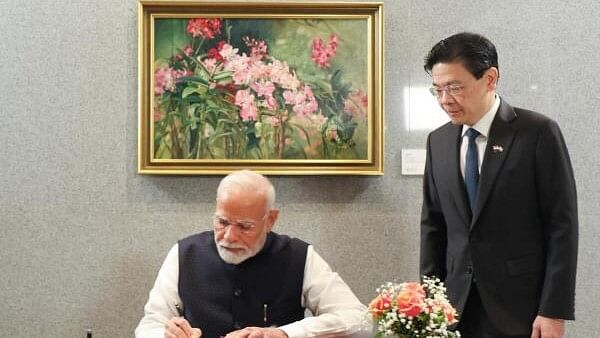
Prime Minister Narendra Modi with his Singapore counterpart Lawrence Wong
Credit: PTI Photo
Prime Minister Narendra Modi visited Brunei and Singapore, two countries that hold vital significance for India’s engagements with South-East Asia in different yet interlinked ways.
More than two decades on, India’s policy towards the East has undergone creative transformations in alignment with New Delhi’s own strategic needs, economic clout, connectivity requirements, the expansionist growth of China, and the re-positioning of American interests in the regional political dynamics.
Though South-East Asia has historic and civilisational ties with India and mutual bonding which is expressed in popular culture and folklore, a comprehensive foreign policy vision for the region came along in the 1990s under the Act East Policy of then Prime Minister P V Narasimha Rao.
Look East under Rao
Unveiling the vision, Rao was guided by both the past and the troubles at hand as he was overseeing an unprecedented economic crisis and tasked with lifting an economy least integrated with the world.
India had taken the lead for the Asian century through measures such as The Asian Relationship Conference organised by Jawaharlal Nehru in 1947, even before India’s Independence, and the Bandung Conference in Indonesia in 1955.
But South-East Asia had become a fiery theatre of Cold War rivalry between the US and the Soviet Union including the Vietnam War and communist insurgencies.
By the time Rao was in power, a new world order was on the horizon. Some of the countries in the region were known as ‘Asian Tigers’ for the economic potential they held and successfully realised later.
Though India’s share of global trade was around $0.5 billion and the trade with the ASEAN bloc was just $2 billion, Rao sensed the future in their policies and economic models.
In geographical terms, this was India’s extended neighbourhood and India shared a 1,640 km land border with one of the ASEAN members, Myanmar.
Guided by a sense of history and a promise of the future, India became a sectoral dialogue partner of ASEAN in 1992, and a full dialogue partner and member of the ASEAN Regional Forum (ARF) four years later. At the first summit partnership for India in Cambodia in 2002, Prime Minister of Singapore — India's bridge country to ASEAN — Goh Chok Tong described India and China as the two wings of the ASEAN aircraft and three years later in 2005 India became a founder member of the East Asia Summit along with the 10 ASEAN countries, Japan, China, South Korea, Australia, and New Zealand. Six years later, the US and Russia too were part of the East Asia Summit, increasing the political and security dimension of the grouping.
Look East under Modi
The foreign policy of a country is mostly a continuum. It gets updated with the changing imperatives of the times and demands of national interests. Soon after taking over as the prime minister in 2014, Modi announced the expanded and extended policy towards the East in conjunction with the geopolitical shifts in the Indo-Pacific.
The US policy of pivot to Asia and China’s vaulting geopolitical ambitions stemming from its economic prowess made the region a strategic hotspot, requiring India to enhance its security and political co-operation with the countries in the region while redoubling its efforts to increase trade and economic cooperation.
The region defies the notions of any unidimensional approach. While remaining a silent claimant to the South China Sea, Brunei, which just saw the first bilateral Indian prime ministerial visit, has effectively been hedging between the US and China. Using its geographical location to the South China Sea, and all-important military bases in the region, Brunei could foster a robust military partnership with the US while being an important member of China’s Belt and Road Initiative (BRI) while building on a forward-looking partnership with India.
The road ahead
From 0.5 per cent, ASEAN countries’ share in India’s global trade has grown to 11 per cent, from $2 billion to $122.67 billion during 2023-2024. Singapore is India’s biggest source of foreign direct investment. Pitched against the export-oriented economies of the region, India needs to do more for its service and agriculture-dominated economy to get better market access. The new thrust given to industries in emerging technologies, promotion of local manufacturing, and addressing the anomalies in the trade pact with ASEAN can embolden the economic relationship.
In geographical terms, India’s Act East Policy with politically volatile Myanmar often hampers India’s plans for connectivity with its Northeast region, and with South-East Asia and beyond in terms of meeting deadlines.
A more co-ordinated effort on connectivity issues will help the cause of physical integration with the region.
(Jayanth Jacob, a foreign policy commentator, has covered the Ministry of External Affairs for over two decades. X: @jayanthjacob.)
Disclaimer: The views expressed above are the author's own. They do not necessarily reflect the views of DH.